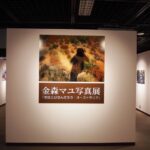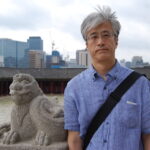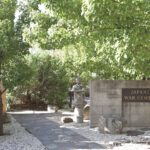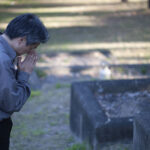
Sandy Edwards Photo by Zorica Purlija
「定住とはなんだろう:オーストラリア」
金森マユは日系オーストラリア人で、ジャンルにとらわれない学際的なアーティストです。東京で生まれ育ち、1981年にオーストラリアに渡りました。移民として彼女はオーストラリアで、ジャーナリスト、研究者、フォトグラファー、マルチメディア・アーティスト、映画制作者としての豊かな貢献をしています。さらに重要なことは、彼女が語り部(ストーリーテラー)、哲学者、そして歴史家としての役割をも担うことになったことで、特筆すべきことです。彼女は大胆かつ強い意志を持った実験者として、展示とパフォーマンスを通し、コラボレーションを活かした自身の手法を自在に融合させています。
金森によるアーティストとしての極めて重要な貢献は、日本とオーストラリアの歴史的な関係を「目に見える形にした」ということです。その作品、そして細かく焦点の絞られた主題を通して、彼女はオーストラリアの歴史における日本の存在、そしてオーストラリアの地に生き死んでいった日本人の歴史について、情熱とある種の義務感を持って全力で向き合っています。これらの歴史はオーストラリアでは広く知られておらず、理解されていません。もっと知ってもらう必要があります。
今回の展示「定住とはなんだろう」では特に、カウラ(ニューサウスウェールズ州)、ブルーム(西オーストラリア州)、タウンズビル(クイーンズランド州)、ローボーン(西オーストラリア州)、ダーウィン(北部準州)などでの日本人の存在に焦点を当てています。オーストラリアには数千にも及ぶ日本人の墓がありますが、正確な数を見積もるのは難しい作業です。太平洋戦争(第二次世界大戦)によるものもあります。戦時中、多くの日本人が強制的に収容所に送られそこで亡くなり、戦没者共同墓地に埋葬されています。ほかの亡くなった方々も、オーストラリアに散らばる日本人墓地や共同墓地に埋葬されています。
オーストラリアと日本の歴史が交差するなかでもたらされた、希望を感じさせる「結果」の一つに、日本人の血を引く人種の混ざった4世代にわたる日系オーストラリア人の存在があります。今回の展示では、日系オーストラリア人家族に賛歌をささげるとともに、オーストラリアでの多文化主義の歴史の中で、人種の入り混じった家族を、心から両手を広げて受け入れています。
オーストラリアが多文化国家であることを問う人は、あまりいなくなりました。しかし日本からの移民は、ヨーロッパや中国など、他の国からの移民に比べて人数が少なく、目立ちにくい存在です。オーストラリアは、今でもイギリス女王が任命する総督を擁する植民地国家です。1788年のイギリスによる「ニュー・サウス・ウエールズ」入植、続くオーストラリア全土の領有が始まる以前から、先住民の長きに渡る6万年の歴史が続いていること、そして合法的に先住民がこの大陸を手放したことはないという事実は、取り組むべき現在進行中の優先事項であり、その大半は手付かずのままです。
オーストラリアに移住した日本人は、歴史的『荷物』を抱え、理解すべき多くの課題に直面します。金森は以前「日本からの移民であるということは、それなりの責任が伴うものであるという事実、それが分かり始めてきた」と語っています。
金森は、これら複雑な歴史と自身が感じる「責任」との折り合いを、芸術活動を通じ、マルチアングルでの相互交流を生み出すことでつけてきました。歴史的な場所を舞台とすることもありました(「イン・リポーズ」2007-2008)。彼女の作品は、例えば写真だけのような従来型の静的なものではなく、写真やダンス、音楽、パフォーマンス、舞台芸術などさまざまな分野のアーティストを巻き込みながら、コラボレーションを活かしたストーリーテリングの形式を取っています(「ヤスキチ・ムラカミ:スルー・ア・ディスタント・レンズ」2014-16)。
「イン・リポーズ」では、日本人移民を供養し、彼らの墓地を手入れする地元の人への感謝を示すことがプロジェクトの目的でした。「ヤスキチ・ムラカミ:スルー・ア・ディスタント・レンズ」は、アデレード、ダーウィン、ブルーム、シドニーを舞台に上演されました。ブルームとダーウィンで活動したフォトグラファーで、第二次世界大戦中、オーストラリアの収容所に入れられた村上安吉の物語です。
金森はこれらの作品で、ナレーターやストーリー内の役柄に自分を置き、例えば調査官やジャーナリストとして、真相に迫るプロセスを進みながら極めて重要となる情報を掘り起こします。彼女のストーリーテリングでは、時間とはストーリーを構成する要素の一つであり、また時間は歴史を表しています。
オーストラリアに埋葬された日本人の存在がオーストラリアで知られていない背景には、第二次世界大戦の影響があります。金森はこれらの事実を目に見えるようにするという自らの「責任」を深く心に刻んでいます。彼女はとても直接的な手法で、自分自身の文化を積極的に受け入れ、日本人に敬意を表しながら、それと同時に、形を変え維持されてきた死にまつわる儀式や埋葬の儀式を軸に、オーストラリア先住民の土地所有者との共通点をあぶり出しています。
今回の展示は、オーストラリアという国が、私たちオーストラリア人が住む土地、さらに人種の混ざった新しい世代の人たちにとって故郷となる土地について、その正当な所有者である先住民に十分な解決策を示してこなかったという、力強い意見の表明です。私たちはオーストラリア人として学ぶことがあります。それは、自分たちが正当な所有権を持っていない国に定住するにあたり、どうやって敬意を表すのかということです。しかしそれでも、私たちは自分たちが定住の場としたこの国をそのまま受け入れ、愛しています。
定住とは、安住の地としてその国を受け入れ、そして生きる場所、死に場所としてその土地がいかに重要であるかを示すことです。
金森マユが敬意を持って描き出す、さまざまな背景の日系オーストラリア人とその子どもたちの活力あふれる元気な表情を見れば、未来への希望が湧いてきます。彼らはオーストラリアを自分たちの故郷として受け入れています。オーストラリアを「ラッキー・カントリー」にしているのは、その地形や気候、そしてコミュニティーの帰属意識です。日系オーストラリア人たちからは、学ぶことがたくさんあります。
金森マユさん、ありがとう!
サンディ・エドワーズ
キュレーター 2022
翻訳:平林純子
サンディー・エドワーズ
CURATOR STATEMENT
Teiju to wa Nandaro Australia
Mayu Kanamori is a Japanese-Australian multidisciplinary artist. Born and raised in Tokyo, she moved to Australia in 1981. In her adopted country, she has made a rich contribution as a journalist, researcher, photographer, multimedia artist, and filmmaker. More significantly she has adopted the role of storyteller, philosopher and historian and become an adventurous and determined experimenter who freely mixes her collaborative methods for exhibition and performance.
As an artist Kanamori has helped to make visible the historical relationship between Australia and Japan. Through her artwork and finely focussed subject matter she is passionately and morally committed to the histories of Japanese presence, of Japanese people living and dying on Australian soil. This history is not widely known and understood in Australia. It needs to be better known.
This exhibition Teiju to wa Nandaro highlights the presence of Japanese in places such as Cowra (NSW), Broome (WA), Townsville (Qld), Roebourne (WA) and Darwin (NT). There are several thousand Japanese graves in Australia. The exact number is hard to estimate. Some graves are the result of the Pacific War (WWII). Many Japanese were interned during the war in camps, died there, and are now buried in the war cemetery in Cowra. Others are in Australian towns in segregated cemeteries or mixed graveyards.
One major life affirming outcome of the historical intersection between Australia and Japan is the emergence of four generations of mixed-race Japanese Australians. This exhibition celebrates the blended families of Nikkei Australians and embraces racially blended families within the history of multiculturalism in Australia.
That Australia is a multicultural nation is no longer a major point of discussion in Australia, however Japanese immigrants are smaller in numbers than other nationalities such as Europeans and Chinese and are less visible. Australia is still a colonial country with a governor general appointed by the Queen of England. The long history of Aboriginal occupation of Australia (60,000 years) prior to the founding of a colony in New South Wales Australia in 1788 and consequently Australia as a whole, and the fact that the land has never legally been ceded, is an ongoing situation that is largely undealt with.
A Japanese person adopting Australia as their home has a lot of historical baggage and understanding to be dealt with. As Kanamori has said ‘I was beginning to understand that the fact that I was an immigrant from Japan meant that I had certain responsibilities.’
Kanamori’s way of negotiating these complex histories and ‘responsibilities’ was to create, through her art practice, a multi-angled interaction sometimes in locations where these histories occurred (In Repose 2007-2008). She made artworks that were not conventionally static (such as photographs) but rather collaborative story telling events that engaged artists across the disciplines of photography, dance, music, performance and theatre (Yasukichi Murakami: Through A Distant Lens 2014-16).
In In Repose the aim of the project was to honour the memory of Japanese immigrants and to show appreciation to the local people who look after the graves. Yasukichi Murakami: Through A Distant Lens was a play staged in Adelaide, Darwin, Broome, and Sydney. It told the story of Yasukichi Murakami who was a photographer in Broome and then in Darwin and who was interned in Australia during WWII.
Within these works Kanamori places herself either as the narrator or a character in her own story, such as an investigator or a journalist, uncovering vital information through a process of discovery. Time is an element in her storytelling and time represents history.
The events of WWII exacerbated this lack of acknowledgement of the presence of Japanese people interned or else buried on Australian soil. Kanamori has taken to heart the ‘responsibility’ of making these facts visible. In a very direct way she has embraced the values of her own culture and paid homage to her countrymen and women while simultaneously shining a light on the similarities between Japanese culture and Indigenous Australian rituals about death and burial.
This exhibition is a powerful statement about the lack of resolution in Australia for the First Nations peoples who are the rightful owners of the land that we as Australians live on, and that the new generations of mixed race heritage also live on and call home. This is something we Australians need to learn – how to respectfully settle in a country in which we have no true ownership of the land, even as we have embraced and loved the country as our own.
To settle is to adopt your country of residence as a place in which to rest your bones and to signify the importance of that land as the place of life and death.
To have hope for the future you only need to look into the vital healthy faces of the mixed race Nikkei Australians and their children portrayed and honoured by Mayu Kanamori. They have embraced Australia as their home. Its landscape, its climate and its sense of community make it the ‘lucky country’. There is much to learn from the Japanese Australians.
Thank you, Mayu Kanamori!
Sandy Edwards
Curator 2022




